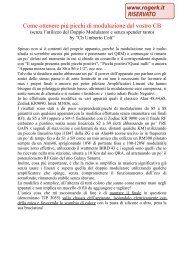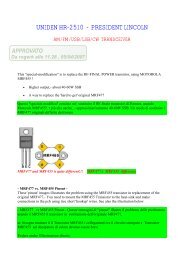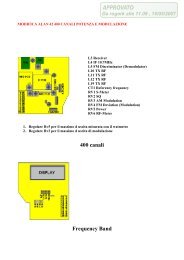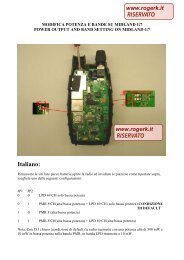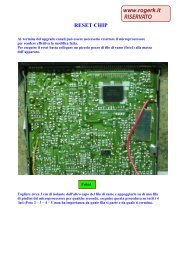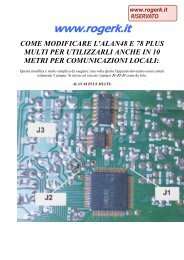Modifications for the ICOM - RogerK
Modifications for the ICOM - RogerK
Modifications for the ICOM - RogerK
- No tags were found...
You also want an ePaper? Increase the reach of your titles
YUMPU automatically turns print PDFs into web optimized ePapers that Google loves.
29-10-1998(IC-275) Splitting into RX- and TX pathsProblem:This is a general transceiver problem. If you want to use <strong>the</strong> transceiver as part of a bigger setup (i.e. with external PA &preamp or with a transverter), it is convenient to have separate access to <strong>the</strong> RX and <strong>the</strong> TX of <strong>the</strong> transceiver. O<strong>the</strong>rwise youneed two coaxial switches every time you add a new accessory. With split RX/TX paths you only need one switch - at <strong>the</strong>antenna. Fur<strong>the</strong>rmore split RX/TX paths eliminates <strong>the</strong> need <strong>for</strong> a change-over sequencer.On <strong>the</strong> o<strong>the</strong>r hand it is also nice to have <strong>the</strong> transceiver working normally when you are using it barefoot.Solution:The solution is to jump wire <strong>the</strong> RX path (between RX and <strong>the</strong> RX/TX switching) trough <strong>the</strong> rear side of <strong>the</strong> transceiver with 2BNC connectors. In normal state <strong>the</strong>se connectors are connected via a short cable. In case you need to "split up" <strong>the</strong> transceiver,you remove <strong>the</strong> short coax cable, and you obtain direct access to <strong>the</strong> RX. The TX is still available using <strong>the</strong> common connector.note: If you are always using your transceiver barefoot, without connecting any PA, preamp or transverter, this modification willoffer no benefit.Remove <strong>the</strong> back cover. If you place <strong>the</strong> holes <strong>for</strong> <strong>the</strong> BNC connectors next to and aligned with <strong>the</strong> two existing DIN-connectors,<strong>the</strong>n <strong>ICOM</strong> have left enough space on <strong>the</strong> inside <strong>for</strong> <strong>the</strong> connections. You can also add o<strong>the</strong>r desired outputs like a phono plug <strong>for</strong>AF OUT.The RX cable runs between J4 on <strong>the</strong> RF YGR PCB and <strong>the</strong> PA unit.note: In my IC-275H <strong>the</strong> PIN-diode <strong>for</strong> <strong>the</strong> FM RF gain is shared with <strong>the</strong> RX/TX switch and placed in <strong>the</strong> PA unit. This meansthat <strong>the</strong> control voltage passes through <strong>the</strong> RX cable.There<strong>for</strong>e <strong>the</strong> breaking of <strong>the</strong> RX cable will cancel <strong>the</strong> FM RF gain function (<strong>the</strong> SSB/CW RF gain is working on <strong>the</strong> AGC and is notaffected). The solution is to install a new PIN-diode (D5) on <strong>the</strong> RF-YGR PCB. The PCB has already room <strong>for</strong> it. To avoid shortcircuiting<strong>the</strong> control voltage <strong>the</strong> jumper placed in stead of C86 on <strong>the</strong> RF-YGR PCB, should be replaced by a 1nF capacitor.This modification is read 691 times.top of page19-07-1998(IC-28) <strong>ICOM</strong> IC-28A AND IC-28H ext frqTo make <strong>the</strong> IC-28 transmit 138-174 MHz, cut D21 (no retuning required). D21 is a tiny glass diode standing on-end near <strong>the</strong>center of <strong>the</strong> upper circuit board, accessible by removing <strong>the</strong> top cover. The IC-28 is <strong>the</strong> only convertible ham rig I know thatcovers <strong>the</strong> 170-MHz federal government (including national park) frequencies.[source: W9MKV]Date: 16-01-2002 User comment From: Giovanni Luce, N8IWKSubject: no cut 28-H modThe 28-H can be modified by removing a wire from a connector that connects to d21. Simply trace <strong>the</strong> circuit from d21 to <strong>the</strong>connector and pull <strong>the</strong> wire out by pressing <strong>the</strong> small metal tab on <strong>the</strong> connector and wrap it in electrical tape.The radio <strong>the</strong>n can easily be "unmodified" by simple plugging <strong>the</strong> wire back into <strong>the</strong> connector.Unsure of pin# or connector number as I modified one over 10 years ago, and didn't bo<strong>the</strong>r to note pin or connector number.This modification is read 1294 times.top of page




